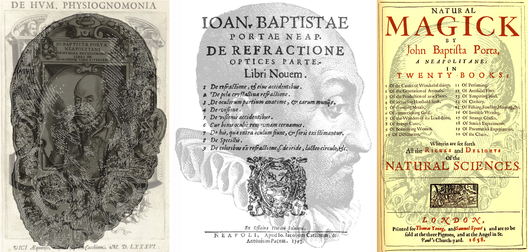Giambattista della Porta1535–1615
The principles of shadow casting were known to scientists in China as early as the 5th century B.C., and the practical optics of the camera obscura, or dark chamber, were described by Chinese scientists in the ninth century A.D. Little in the way of a theory of image formation is considered to have derived from these experimental enquiries. Ibn al‑Haytham or Alhazen (ca.965-1039) described an inverted image in a dark chamber, and pinhole experiments were conducted by late medieval students of optics. However, the equation of such optical image forming devices with the eye appeared much later. Leonardo da Vinci conducted experiments with a camera obscura (a dark room with a small aperture in one wall), and drew an analogy between its operation and that of the eye. In this regard, as in many others, his ideas were neither published nor widely known until long after his death. An Italian humanist, Daniele Barbaro (1513-1570), appreciated the assistance that the camera obscura could offer to the painter, particularly when a convex lens was placed in an enlarged aperture. Despite these earlier accounts, it is Porta who has most frequently been accorded the distinction of equating the optics of a camera with those of the eye, not because he was the first to reach that conclusion, but because his description in Natural Magick (1589) was the most widely read. This book, which was an amalgam of mysticism, folklore, and science, was reprinted in many editions, and translated into several languages. Porta concluded that forming an image on a surface was an adequate account of “how vision is made”, but he still considered that the image was formed on the rear surface of the lens. Magiae Naturalis Libri was initially published as four books in 1558 and extended to twenty books in 1589. In the latter, Porta described a combination of convex lenses capable of magnifying the image of an object. He is thus sometimes credited as being the first to conceive a telescope, a priority that he actively reclaimed after Galileo’s success in the observation of the sky. In 1593, he devoted a book specifically to optics, De Refractione, and in this he described a simple test to determine eye dominance. He is also remembered for his book on human physiognomy, and three portraits of him are displayed within the title pages of these three books. Porta, whose name was variously given as Giambattista della Porta, Giovanni Battista della Porta and Johannes Baptista Porta, founded one of the earliest scientific societies, Academia Secretorum Naturae, at some time before 1580 and he was elected member of the Accademia dei Lincei, the academy of which Galileo was the most eminent member.
